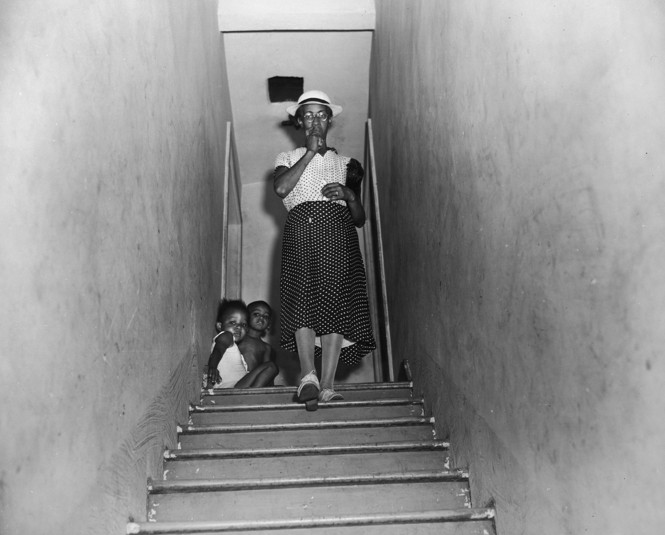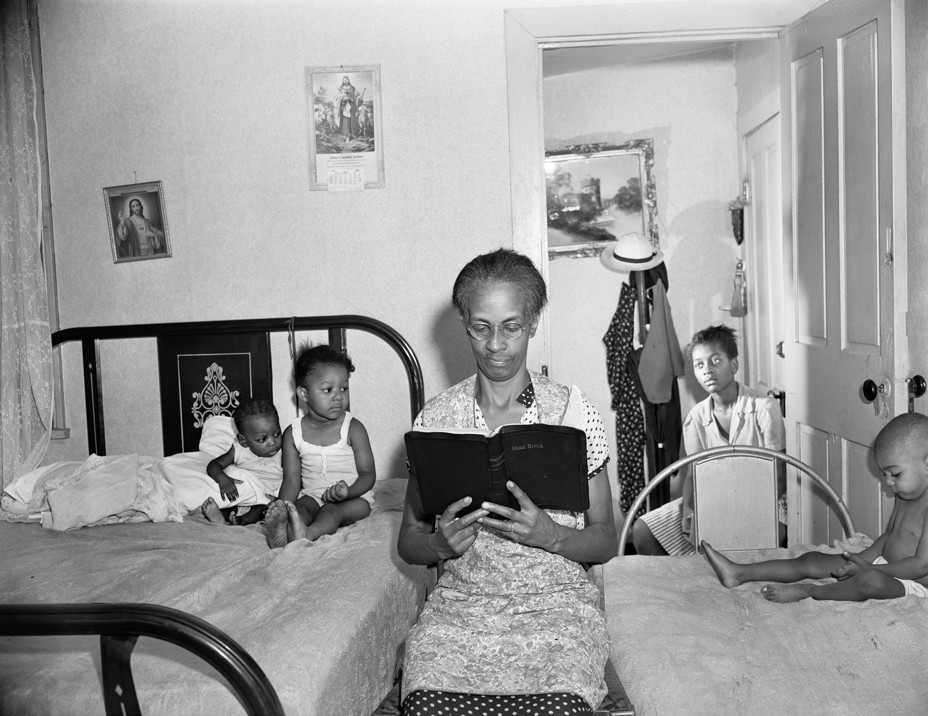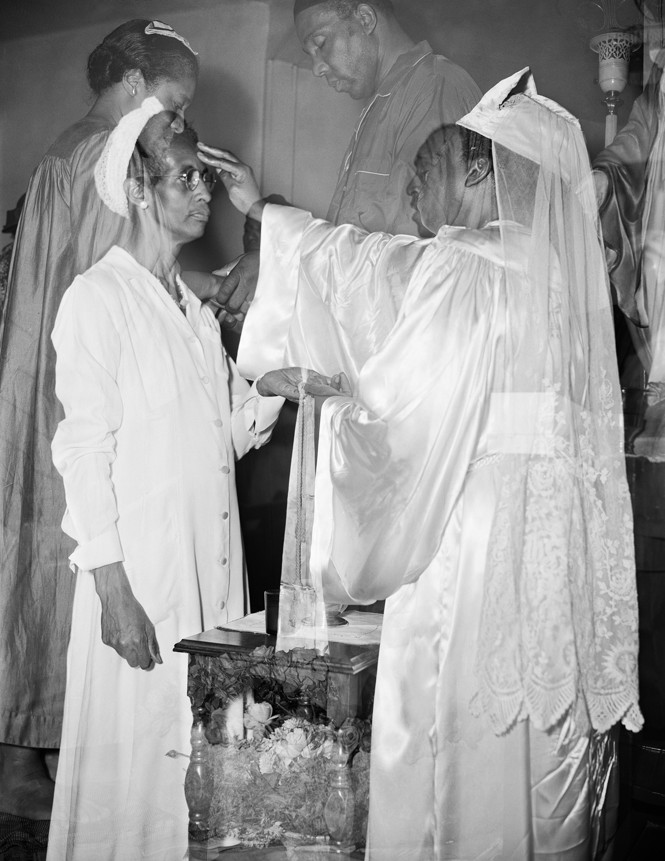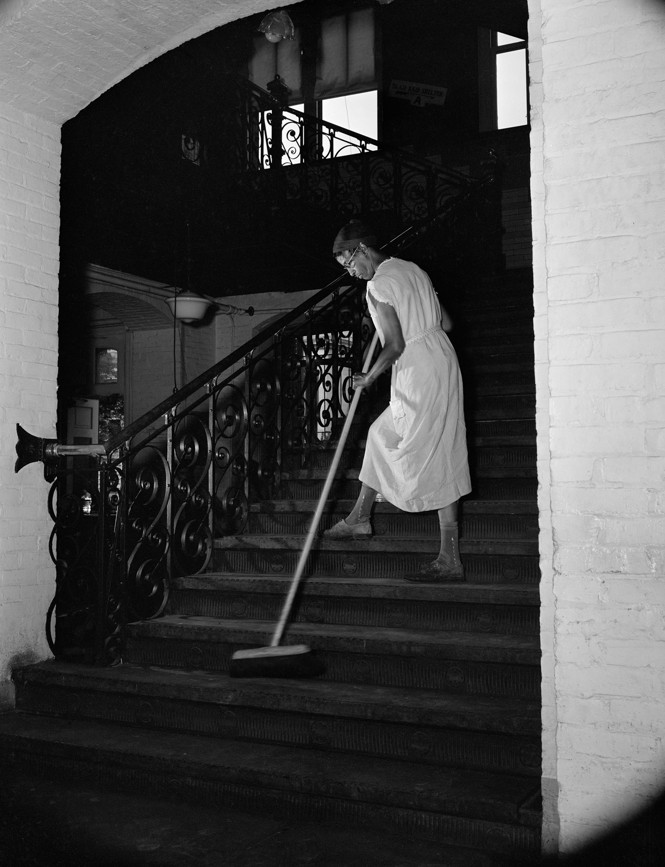Her Name Was Ella Watson
Photographs by Gordon Parks
I
am the granddaughter of domestic workers. My maternal grandmother was Luretha Little, an only child, who left her parents behind in North Carolina, and then her husband and two young sons in Virginia in search of freedom in New Jersey, where her sons eventually joined her and where my mother was born in 1955. In Newark, Luretha and her second husband, Elijah Griffin, had four more children. They ran a janitorial business, cleaning the offices of white doctors in Woodbridge and white scientists in New Brunswick. Sometimes they brought their children and put them to work: the twin boys swept the floors, and my mother dusted desks and polished ashtrays. My paternal grandmother, Hilda Ramdoo, was nicknamed Dolly because she was a pretty baby. One of nine children born in Port-of-Spain, Trinidad, she had seven of her own. By the time my father was an adult, his mother had temporarily left her husband, Antonio Tillet, and remaining six children to work in Caracas, where she cleaned the homes of the Venezuelan elite; she later went to Boston, where her entire family eventually joined her, and where I was born in 1975.
I think a lot about these two women and their countless hours of labor in the homes or offices of others. Though they were separated by race, nationality, and age, because of their gender and class they were relegated to the same job. But they also had full lives. Seven children each. Luretha loved Mahalia and Motown. Dolly was one of the first women to start a Carnival band in Trinidad. They were pious and proper and quick-tongued and outspoken. I think a lot about what existed for them beyond work when I look at Gordon Parks’s most memorable image: the 1942 photograph he initially labeled Washington D.C. Government Charwoman, but renamed American Gothic during the revolutionary 1960s.
More than half a century later, Parks recounted making this first portrait of Ella Watson, the 59-year-old African American cleaning woman who, like him, worked at the Farm Security Administration offices in Washington, D.C. “So it happened that, in one of the government’s most sacred strongholds,” he wrote, “I set up my camera for my first professional photograph.”
“On the wall,” he continued, “was a huge American flag hanging from the ceiling to the floor.” Parks asked Watson “to stand before it, placed the mop in one hand, a broom in the other, then instructed her to look into the lens.”
This capture of Watson at work—wearing a neatly pressed polka-dotted puffed-sleeve dress and wire-rimmed glasses, her hair parted to the side, with a straw broom and rag mop on either side of her and a slightly out-of-focus American flag hanging behind her—is now so familiar to me that I don’t remember when I first saw it. But I didn’t know until recently that it is what Parks considered his “first” professional photograph, setting him on the path to becoming one of the most innovative and influential photographers of all time.
 Washington DC. August 1942. Mrs Ella Watson, a government chairwoman, leaves for work at 4:30pm. (The Gordon Parks Foundation)
Washington DC. August 1942. Mrs Ella Watson, a government chairwoman, leaves for work at 4:30pm. (The Gordon Parks Foundation)
In July and August 1942, Parks took more than 90 photographs of Watson, her family, and her community, in a project that rejected long-standing caricatures of Black women as mammies or subservient maids. More than a decade before hundreds of Black women domestic workers helped organize the Montgomery bus boycott, Parks’s series with Watson revealed Black domestics as they often were: patriotic, political, and pious.
In his memoir, A Choice of Weapons, Parks recalled entering the FSA offices for the first time, walking “confidently down the corridor, following the arrows to my destination, sensing history all around me, feeling knowledge behind every door I passed.” Roy Stryker, the head of the FSA’s Historical Section, sensing that Parks’s naivete would not serve him or his future subjects well, encouraged him to leave his camera behind and get to know the city by going for a bus ride, taking in a movie, shopping at a drugstore or a department store, or dining at local restaurants. “I wanted to kill everyone,” Parks said about those experiences. “I’ve never been so mad.” Unlike in Saint Paul, where he came of age, or even his more recent home, Chicago, in D.C., he faced the harsh reality of the district’s strict segregation laws and was denied service or entry everywhere he went. Furious, Parks told Stryker that he needed to document this story of American racism and then plotted his plan in bold strokes. “I wanted to photograph every rotten discrimination in the city, and show the world how evil Washington was,” Parks said. “I had the biggest, vaguest ideas in the world.” After making it clear that such a project would require him to hire all of Life magazine’s photographers for the rest of their lives, Stryker encouraged Parks to focus on and follow one person to achieve his goals. Stryker indicated a woman who was mopping the hallway floor nearby. “Go have a talk with her before you go home this evening,” he said. “See what she has to say about life and things. You might find her interesting.”
 (The Gordon Parks Foundation)
(The Gordon Parks Foundation)
Born in late March 1883 in Washington, D.C., Ella Watson had been a domestic for most of her life by the time she met Parks. In 1898, at age 15, she left school and later that year found a job ironing at the Frazee Laundry in Washington. She worked intermittently, listing “maid” and “laundress” as her employment on the census until she found a temporary position as a custodian at the State Department in 1919. The following year, she doubled up, working as a caretaker in a white family’s home and cleaning another federal agency building. She managed to secure steady employment at the Post Office Department for most of the 1920s, then moved to the Treasury Department (where the FSA was also located) in 1929; she remained there until 1944. “I came to find out a very significant thing,” Parks later remembered. Watson “had moved into the [office] building at the same time, she said, as the [white] woman who was now a notary public. They came there with the same education, the same mental facilities and equipment, and she was now scrubbing this woman’s room every evening.”
I have always wondered whether Parks saw parts of his biography in Watson’s story. Long before he worked for the railroad, much less became a professional photographer, a teenage Gordon Parks was homeless in his new city of Saint Paul. He worked weekends at his boardinghouse to make ends meet, washing dishes and mopping floors. A few years later, like millions of Americans during the Depression, he was destitute again. Having lost all his belongings on an earlier trip to Chicago, a desperate Parks got a gig at the Hotel Southland. Because of his race, this run-down establishment barred him from renting one of the rooms he was responsible for cleaning.
Having to clean for the hotel’s white, working-class, and almost always drunk guests brought out the worst in him. The Southland was filled with a “bad breath of smoke, alcohol, sour bodies and human excrement” and “pickpockets, alcoholics, bums, addicts, perverts, panhandlers,” and the only way Parks could survive was to “hold my own here, where profanity meant prestige and politeness invited abuse.” Hating every day of his short-lived experience there, Parks concluded, “It was a harsh and ugly time,” marked mainly by his “longing for the time when I could get into a tub of hot water and soak out the smell of the place.”
I do not know if Parks divulged his past to Watson, but she shared much with him. “Would you allow me to photograph you?” he awkwardly asked her one early-summer evening in 1942. “In an old dress like this?” she humbly replied. Soon Parks had his most enduring photograph, but he realized he knew little of his subject beyond the image. When he approached her later to ask if he could continue to document her and learn more about her life, Watson joked that it might take some time because she was a grandmother. She then told a life story that sounded to Parks like “a bad dream.” By the time he met her, her husband had died (in 1927), and she was raising her adopted teenage daughter and her adopted daughter’s nieces and nephews. Watson, a single mother and the sole provider for the family, was left to survive on an annual wage of $1,080. And she knew she was locked permanently into this status.
Whether Parks consciously identified with Watson as a domestic remains unclear. But in the actual photographs, we can see his identification with and respect for her as a laborer in unexpected ways. Rather than remove all evidence of himself in the portraits of Watson cleaning the offices, he subtly included traces of his photography equipment. Parks established a reciprocity between their lives and their labor. He knew it was not a one-to-one correlation. “By comparison,” he reflected after learning of Watson’s hardships, “my experiences were akin to a peaceful afternoon.” The images were trenchant critiques of the limited economic opportunities available to Black people, particularly Black women in Jim Crow America, while they also told Watson’s story with visual nuance and depth.
 Washington, DC. August 1942. Ella Watson cleaning after regular working hours. (The Gordon Parks Foundation)
Washington, DC. August 1942. Ella Watson cleaning after regular working hours. (The Gordon Parks Foundation)
 Washington DC. August 1942. Mrs. Ella Watson, a government chairwoman, reading the Bible to her house-hold. (The Gordon Parks Foundation)
Washington DC. August 1942. Mrs. Ella Watson, a government chairwoman, reading the Bible to her house-hold. (The Gordon Parks Foundation)
Stryker immediately understood the disruptive power of Government Charwoman. Balking after Parks showed it to him, he said, “Well, you’re catching on, but that picture could get us all fired.” Aware that southern members of Congress had already complained about the FSA’s publishing images of Black people impoverished in the segregated South, Stryker encouraged Parks to continue documenting Watson.
The most dominant image of Black domestic workers in mainstream America at the time was that of a mammy, a Black woman who happily served at the whims of white employers. By 1941, the image had peaked: Hattie McDaniel won the Best Supporting Actress Oscar for her role as Ruth “Mammy,” a formerly enslaved woman on the Tara plantation and house servant to Scarlett O’Hara in the pro-Confederate movie Gone With the Wind. Years later, when a friend criticized her for “playing so many servant parts, or ‘handkerchief heads’ as they came to be called,” McDaniel responded, “Hell, I’d rather play a maid than be one.”
Although Parks was not alone in creating a counternarrative to racist stereotypes, his image remains one of the most enduring. Two years before Parks arrived in the capital, his literary hero Richard Wright sent his agent a manuscript titled Slave Market (later renamed Black Hope), about the plight of Black housemaids. Wright hoped the novel might “reveal in a symbolic manner the potentially strategic position, socially and politically, which women occupy in the world today.” But he never published the book, and another eight years would pass before Lutie Johnson, a domestic worker turned blues singer, would appear in print in Ann Petry’s social-realist novel The Street.
Parks never saw Watson as just a symbol. Through sustained documentation of her life, the civil-rights aesthetic he pursued and perfected for the rest of his career took form. In that brief encounter with Watson, her friends, and her family, Parks realized his capacity to depict Black people in his art the way he knew them in the world: as multidimensional, multitudinous, and agents of social change.
He achieved this, in part, through a swap. Parks later admitted to having Grant Wood’s American Gothic in mind when he placed Watson in a pose similar to that of both figures in Wood’s 1930 painting. Parks likely saw the painting—now one of the most recognizable of 20th-century American art—during a train layover in Chicago in 1937. Unlike the sharp social commentary of the FSA photographs, Wood’s painting was both bucolic and nostalgic. The obvious middle-classness harkened back to an age of prosperity and stability before the Great Depression. “What does matter is whether or not these faces are true to American life,” Wood wrote about his models in a 1941 letter, “and reveal something about it.”
Recently, I went to see Wood’s American Gothic on a lark. I had seen the painting many times as one of the many tourists who flock to the American wing of the Art Institute of Chicago, looked at it from various angles, and debated its import as kitsch or haute culture. But this time, I had Parks and Watson in my head, and I found myself less interested in the farmer and his daughter (many people mistake the woman for a wife) and more invested in Parks’s transformation of a double portrait into a single one.
In Parks’s version, Watson stood in for both figures. In Wood’s painting, the division of labor falls along traditional gender lines. The older man and the younger woman are outdoors, and the pitchfork is the main clue to their labor. The farmer uses it daily, making it a crucial part of his routine and work, as the painting suggests, in public. The young woman’s gaze suggests a dependency on him, and her kitchen garb indicates that she does not work alongside him but might take care of the home. By replacing those two figures with Watson, a Black cleaning woman, Parks troubled the notions of gender, race, and work. As Watson cleaned those stairwells and offices in the after-hours, the wartime bureaucracy of the FSA became a domestic space, and women’s labor was no longer unseen.
I am drawn to those photographs that fully refuse Watson’s invisibility and revel in her interiority. Parks travels with her far beyond the office building and witnesses her different types of emotional, familial, and intergenerational labor: her preparing to go to and returning from work; her feeding and dressing her grandchildren, and combing their hair.
 Washington DC. August 1942. Mrs. Ella Watson receives anointment from Reverend Clara Smith during the Flower bowl demonstration, a service held once a year at the St Martin’s Spiritual church. (The Gordon Parks Foundation)
Washington DC. August 1942. Mrs. Ella Watson receives anointment from Reverend Clara Smith during the Flower bowl demonstration, a service held once a year at the St Martin’s Spiritual church. (The Gordon Parks Foundation)
 Washington DC. August 1942. Mrs. Ella Watson, a government chairwoman, with three grandchildren and her adopted daughter. (The Gordon Parks Foundation)
Washington DC. August 1942. Mrs. Ella Watson, a government chairwoman, with three grandchildren and her adopted daughter. (The Gordon Parks Foundation)
Interspersed are moments in which Watson created an alternative to the racism she experienced at work and a curative to her daily grind. As poignant as but less popular than her overt dissent in front of the American flag in the most famous photograph is her embrace of religious ritual and her exercising her right to rest. Tenderness is on display when Watson’s grandchild naps midafternoon or when we see her silhouette projected on the mirror behind her bedroom altar. Eyes closed, head down, Watson appears in a solo portrait again, but this time in prayer. Parks helps us see how, despite her economic poverty, surrounded by rows of neatly lined-up statues and candles, Watson made her home a sanctuary, a place where she, and maybe even he, for a time, could connect to something far better than the segregated country into which they both were born.
“I was in my very late teens when I was first made aware of the images,” Ella Watson’s great-granddaughter Rosslyn Samuels told me in an interview. “And I didn’t grasp the magnitude of it until my later years, because, to me, she was just Grandma.” When she saw Parks’s photographs, she said, “I thought, Oh, someone took professional pictures of her. I regret not knowing about them when she was alive, because she and I shared a bedroom, and we talked about everything.” Knowing Watson only as a retiree meant that Samuels’s primary memories of her great-grandmother are more like the photographs Parks took outside the office, the large majority of moments he documented: Watson as a loving, pious, nurturing Black woman who seemed to delight in looking after those she loved.
And here, Watson still inspires. “I get an overwhelming feeling when I look at Parks’s photographs of her now,” Samuels revealed. “It’s just like, ‘Wow.’ But … I’m not surprised, because she was always so big to us. She had that impact on a lot of people. We revered her. And it’s not like she commanded it; she just had a certain effect on people.”
Fortunately, one of them was a 29-year-old photographer named Gordon Parks.
 (The Gordon Parks Foundation)
(The Gordon Parks Foundation)
This article has been excerpted from “’She Was Always So Big to Us’: Ella Watson as Style and Substance," an essay by Salamishah Tillet, that appears in Gordon Parks's new book American Gothic: Gordon Parks and Ella Watson.
-
Ashley Madison reveals top 20 American cities for adulterous behavior: ‘Something is going on in the Midwest’ Ashley Madison chief strategy officer Paul Keable provided Fox News Digital with an exclusive look at the 20 cities across America that are "hot spots for non-monogamy."foxnews.com
-
Heart attacks more likely during presidential elections and other stressful times, study shows People with high genetic stress sensitivity, as well as anxiety or depression, are at a much higher risk of heart attack during times of socio-political stress. Doctors explain.foxnews.com
-
Iran Video Shows Shock Moment President Raisi's Death Announced Wailing could be heard during the announcement at Iran's largest mosque.newsweek.com
-
Russia's Black Sea Fleet Loses Another Warship: Reports Russia used occupied Crimea as its primary Black Sea base but Ukrainian strikes have forced Moscow to relocate many of its assets further east.newsweek.com
-
Aileen Cannon's Latest Jack Smith Filing Torn Apart by Legal Analysts The judge overseeing Donald Trump's classified documents case wrote that she was "disappointed" in special counsel Jack Smith.newsweek.com
-
Joe Biden Handed Gun Control Loss by Texas Judge A judge blocked a Biden administration rule that would close the so-called gun show loophole.newsweek.com
-
South Africa’s Highest Court Says Jacob Zuma Can’t Run in Election The political comeback of Mr. Zuma, the former president and onetime leader of the African National Congress, has presented a test for the country’s fledgling democracy.nytimes.com
-
Linguist Reveals the Secret Behind Trending US Baby Names "It's really interesting to see how prominent the patterns were," Northeastern University linguist Adam Cooper said.newsweek.com
-
My Father Kept Secret His Mother's Deathbed Apology. It Stopped Me Cold As a little boy, I was mystified by his penchant for stillness and solitude. Hard on himself, my father could be hard on us too.newsweek.com
-
Today's 'Wordle' #1,066 Answer, Clues and Hints for Monday, May 20 Game "Wordle" isn't always easy, so if you are struggling with today's puzzle, Newsweek has some clues to help you out.newsweek.com
-
Dog Food Recall Map Shows States Impacted: 'Monitor for Unusual Behavior' Affected bags of pet food are being recalled in four southern states.newsweek.com
-
NY v. Trump to resume with continued cross-examination of Michael Cohen as trial nears conclusion Former President Trump’s criminal trial is expected to resume Monday with Michael Cohen on the stand for the third day of cross-examination by defense attorneys.foxnews.com
-
Advocates for IRS whistleblowers accuse Special Counsel Weiss of retaliation, misleading: ‘Smear campaign’ Lawyers for two IRS whistleblowers claim special counsel "hid and twisted" information, prompting angst on Capitol Hill about alleged politicization of the Biden Justice Department.foxnews.com
-
NYT 'Connections' Hints May 20: Answers and Clues for Puzzle #344 If today's "Connections" brainteaser is proving to be a struggle, Newsweek has some handy hints to help you out.newsweek.com
-
Dear Abby: My husband’s daughter is annoyingly self-involved Dear Abby weighs in on a self-absorbed daughter and a new member of the LGBTQ community who is not accepted by their family.nypost.com
-
How Lollapalooza Changed Rock Music Forever Paramount+During its trailblazing heyday, Lollapalooza provided an unparalleled platform for the alternative. The problem was that by doing so it made the alternative mainstream, which ultimately caused the summer music festival to betray its roots—an inevitable evolution that stands as the most fascinating aspect of Lolla: The Story of Lollapalooza, a nostalgia-fest which understands that all good underground things must either die or become the very thing against which they rebel.Ironically, Michael John Warren’s three-part Paramount+ docuseries (May 21) is somewhat undercut by a similar dynamic, given that its own desire to end on a happy note means that it must ignore the fact that there’s no going home again to recapture the magic that made a sensation truly sensational in the first place. As a result, it’s ultimately more promotion than critique.Lollapalooza launched in 1991 as the brainchild of Perry Farrell, frontman for the paradigm-shifting band Jane’s Addiction, who—along with cofounders Ted Gardner, Don Muller, and Marc Geiger—viewed it a way to channel the spirit of England’s Reading Festival (and its ilk) by bringing together an assorted line-up of artists on a single stage. Designed as a farewell for Jane’s Addiction, which planned to disband once this run of shows was completed, it quickly blossomed into an invigorating new take on an old format. Attendees were offered not just one great performance after another, but a common area filled with local avant-garde artists, social activist booths that sought to raise awareness about guns, the environment, and voting, and additional attractions that made it an immersive day-long experience directly attuned to the era’s youth culture.Read more at The Daily Beast.thedailybeast.com
-
Truth About the Wild Drug-Taking and Illegal Booze on Ukraine’s Front Lines Photo Illustration by Thomas Levinson/The Daily Beast/GettyKHARKIV, Ukraine—Fighting on the front lines has taken a disastrous turn for the worse after Russia broke through Kharkiv’s line of defense on May 10. Throughout Eastern Ukraine, the brutal repercussions of the six-month-long pause in new U.S. aid led to massive losses on the battlefield. Ukrainian soldiers risking their lives for their country are suffering from physical and psychological trauma. With few ways to decompress from the all-encompassing effects of war, many are turning to drugs and alcohol as a way to cope, which has plunged the military even deeper into darkness.Alcohol is banned in Donbas, the region that has been the epicenter of the war, and all stores and restaurants are forbidden from selling it, but still it makes its way to the front lines via off-rotation soldiers, volunteers, smugglers who charge outlandish prices, or journalists, who bring it in as a peace offering before they begin their interviews.Multiple soldiers who spoke to The Daily Beast claim that some of those defending Ukraine are also abusing illegal substances that they buy through shady online businesses run by the country’s mafia. Some, they say, are drunk at military positions. The men claim that some of their comrades have been so drunk or high that they have killed civilians, soldiers, and animals in a blind rage or while driving under the influence.Read more at The Daily Beast.thedailybeast.com
-
American couple stranded in Brazil facing 'bureaucratic nightmare' after newborn son arrives months early Bureaucratic red tape has left a Minnesota couple stranded in Brazil after their son was born months earlier than expected.foxnews.com
-
Rhode Island police officer and shelter pup pair up for rescue and renewal: 'Can achieve great things' A shelter dog in Rhode Island rejected by multiple families is finally picked by a police officer — who helps the dog finds its purpose in life in a heartwarming, faith-filled family story.foxnews.com
-
When Will the Hottest Bridgerton Finally Get His Own Season? Liam Daniel/NetflixDearest gentle reader, I recognize that the laws of attraction can be fickle. The very same features that might make one person quiver beneath her bodice might, in fact, stir nothing but disgust for another. The flirtatious habits that once made a bachelor’s eyes sparkle during one season might bore him to tears in another. Nevertheless, I must ask: What the hell is going on with the hottest brother in Netflix’s Bridgerton? No, I’m not talking about Anthony, the dreamy (now married) Viscount played by Jonathan Bailey. I’m talking about his younger brother, Benedict, whose love life has been a hot, sexy mess for three seasons. Sex appeal might be subjective, but as far as this writer is concerned our boy Benny checks all the right boxes: He’s got gorgeous blue eyes, witty ballroom comments, and a soul-meltingly mischievous smile. Also, he’s the most reliable of his many, many siblings. Too bad Bridgerton can’t seem to decide what to do with him. Next season will likely belong either to Benedict or his younger sister, Eloise, who already made a catastrophic debut on the Ton’s marriage mart in Season 2. But if we really are moving on to Benedict, it’s going to take some real finessing to stick the landing.Read more at The Daily Beast.thedailybeast.com
-
Renting is Increasingly Cheaper Than Buying a Home Mortgage rates remain high throughout the U.S. and a lack of supply is keeping home prices up.newsweek.com
-
Taiwan’s New President Extends an Olive Branch to Beijing. It Matters Little For William Lai’s inauguration speech, the priority seemed to sound the right notes and avoid any language that could be construed as an affront.time.com
-
Mike Schur Knows 'Parks and Rec' Would Have Seemed 'Naive' Post-Trump Photo Illustration by Thomas Levinson/The Daily Beast/Getty/NBCWhen Parks and Recreation first premiered in spring 2009, we were all living in a different world. Wide belts, baker boy hats, and multi-colored tights were all the rage. Everyone was worried about swine flu. And a charismatic politician named Barack Obama had just been inaugurated as our first Black president. For many, it was a time of hope. It’s no wonder Amy Poehler’s unforgettable public servant Leslie Knope and her many, many eccentric neighbors and colleagues stole our hearts.Parks and Rec might’ve faced a shaky reception during its first season on NBC, but it didn’t take long before the long-running sitcom became inescapable. Most of its core cast have become famous in their own right—Adam Scott, Aubrey Plaza, Chris Pratt, Nick Offerman, Aziz Ansari, Rashida Jones, and even smaller players like Ben Schwartz and Jenny Slate. Part of that success might have to do with the show’s organizing mantra, known internally as “The Poehler Rule.” The directive, said co-creator Mike Schur, was always to hire the funniest possible person for any given role—whether it was a bit part or a season-long arc.“It seems so obvious, but a lot of shows don't always do that,” Schur told The Daily Beast’s Obsessed during a recent conversation about the show’s legacy and longevity. “They have some other criterion that they think is more important. It turns out, there's nothing more important for comedy than just being funny.”Read more at The Daily Beast.thedailybeast.com
-
Courteney Cox says late ‘Friends’ co-star Matthew Perry still ‘visits’ her Cox, who starred as Monica Geller alongside Perry's Chandler Bing for 10 seasons on "Friends," commemorated the 20th anniversary of the sitcom’s series finale.nypost.com
-
Putin Makes Vow to Iran After Ebrahim Raisi's Fatal Helicopter Crash Iran's ambassador to Russia told state media about his emergency meeting with Putin.newsweek.com
-
Biden courts battleground state Black voters with two big speeches In Atlanta, Georgia and Detroit, Michigan, the president made overtures to Black voters while addressing Gaza and attacking Trump.cbsnews.com
-
Many remember solid economy under Trump, but his record also full of hype, debt Numbers show that the economy during Donald Trump’s presidency has never lived up to his own hypeabcnews.go.com
-
New Yorkers Blame Migrants for City's Crime Rate According to the NYPD, the overall crime index in April 2024 declined by 4.9 percent compared to same month in 2023.newsweek.com
-
HAMAS Issues Statement on Iran President's Raisi's Death "We express our shared feelings of grief and sorrow," the Palestinian group backed by Tehran said.newsweek.com
-
Casa Blanca destaca próximo enfrentamiento con republicanos por los recortes fiscales de 2017 Trump ha argumentado que la expiración de todos sus recortes fiscales provocaría despidos masivos que podrían paralizar permanentemente la economía.latimes.com
-
Donald Trump Fires Back at Claims He 'Froze' During Rally Joe Biden's campaign team said a 30-second video clip shows Trump having "glitched out and froze."newsweek.com
-
London court to decide whether WikiLeaks founder Assange is extradited to the US WikiLeaks founder Julian Assange faces a court hearing in London that could end with him being sent to the U.S. to face espionage charges, or provide him another chance to appeal his extraditionabcnews.go.com
-
‘Mr. Raider’ Jim Otto, Football Hall of Famer, Dies at 86 Jim Otto, a Hall of Fame center known as “Mr. Raider” for his durability through a litany of injuries, is considered one of the AFL’s all-time greats.time.com
-
FDNY firefighter who nearly died fighting NYC house fire released from Bronx hospital Firefighters from the Bronx and Queens were on hand to greet the 38-year-old who shook hands with each of his fellow Bravest during the touching moment, FDNY footage shows.nypost.com
-
Who Will Lead Iran After Ebrahim Raisi’s Death? Long-Term Impacts of the President’s Passing The death of Ebrahim Raisi, who was expected to succeed Supreme Leader Ayatollah Ali Khamenei, has consequences for the future of one of the most powerful positions in the Middle East.time.com
-
What a blast to work at NASA. Space agency is sky-high again in latest survey of federal employees Exploring the cosmos makes for happy employees, federal workers like to work from home like everyone else, and an agency that has struggled with low morale is showing improvementabcnews.go.com
-
UNICEF: crece 40% el tránsito de niños por la jungla del Darién en lo que va de 2024 Esa cifra forma parte de los más de 139.000 extranjeros que realizaron esa ruta en lo que va de 2024, la mayoría de ellos venezolanos, haitianos, chinos y ecuatorianos.latimes.com
-
Oakland locals blame homeless encampment for city removing traffic lights to stop copper thieves The lights had been working on and off for months due to criminals tampering with the electricity and stealing the wires, the report said.nypost.com
-
Presidente iraní y otros son hallados muertos en sitio de choque de helicóptero, dice prensa estatal El incidente se produjo en medio de tensiones en Oriente Medio por la guerra entre Israel y Hamáslatimes.com
-
Raiders legend, Hall of Famer Jim Otto dead at 86 Longtime Raiders center Jim Otto died at 86, the team announced Sunday night.nypost.com
-
Timberwolves overcome 20-point deficit to stun defending-champion Nuggets in Game 7 The Minnesota Timberwolves were down 20 points at one point in their Game 7 matchup against the Denver Nuggets, but they overcame the deficit to reach the Western Conference Finals.foxnews.com
-
The List of Potential Suspects in the Mysterious Death of Iran’s President Raisi President Ebrahim Raisi’s helicopter crashed in the northwest of Iran on Sunday, May 19.time.com
-
Saudi Crown Prince MBS Postpones Japan Trip Amid Concerns About Saudi King’s Health Saudi Arabia’s Mohammed bin Salman, who handles most day-to-day affairs in the kingdom, is next in line to the throne.time.com
-
Tom Thibodeau wants to stay with Knicks as extension talks loom: ‘Where I want to be’ With no extension, Thibodeau, 66, would enter next season in the final season of his five-year deal and coaches typically don’t make it to lame-duck status.nypost.com
-
Knicks’ late rally spoiled by costly turnovers in Game 7 downer Even with their roster hurting and their available players somehow dwindling further, the Knicks cut into what had been a 23-point hole and climbed within seven points during Sunday’s third quarter.nypost.com
-
Cruz Azul pierde con Monterrey, pero avanza a la final del Clausura donde se citará con el América Después de perder en temporada regular con América, el entrenador argentino de Cruz Azul, Martín Anselmi dijo que le gustaría volverlos a ver más adelante.latimes.com
-
Alex Rodriguez couldn’t contain excitement for Timberwolves’ upset of Nuggets: ‘Let’s f–king go’ Multiple shots of A-Rod during the TNT broadcast showed just how ecstatic the former MLB star was for the Timberwolves to advance to the Western Conference Finals with a win over the defending NBA champion Nuggets.nypost.com
-
Iran's President Raisi killed in helicopter crash, state media confirms Iran's President Ebrahim Raisi has died in a helicopter crash, Iranian news agencies have reported. Follow for live updatesedition.cnn.com


